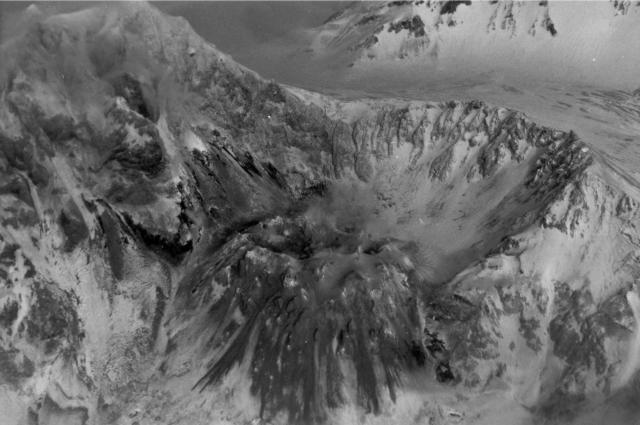Report on Sheveluch (Russia) — March 1990
Bulletin of the Global Volcanism Network, vol. 15, no. 3 (March 1990)
Managing Editor: Lindsay McClelland.
Sheveluch (Russia) 100-m explosion vent in center of lava dome; minor fumarolic activity
Please cite this report as:
Global Volcanism Program, 1990. Report on Sheveluch (Russia) (McClelland, L., ed.). Bulletin of the Global Volcanism Network, 15:3. Smithsonian Institution. https://doi.org/10.5479/si.GVP.BGVN199003-300270
Sheveluch
Russia
56.653°N, 161.36°E; summit elev. 3283 m
All times are local (unless otherwise noted)
During a 2 February overflight, an explosion vent more than 100 m in diameter was observed in the center of the [extrusive] hornblende andesite lava dome (figure 1). Minor fumarolic activity was occurring.
 |
Figure 1. Crater and lava dome at Shiveluch, looking roughly N on 2 February 1990, showing explosion vents. Courtesy of B.V. Ivanov. |
Geological Summary. The high, isolated massif of Sheveluch volcano (also spelled Shiveluch) rises above the lowlands NNE of the Kliuchevskaya volcano group. The 1,300 km3 andesitic volcano is one of Kamchatka's largest and most active volcanic structures, with at least 60 large eruptions during the Holocene. The summit of roughly 65,000-year-old Stary Shiveluch is truncated by a broad 9-km-wide late-Pleistocene caldera breached to the south. Many lava domes occur on its outer flanks. The Molodoy Shiveluch lava dome complex was constructed during the Holocene within the large open caldera; Holocene lava dome extrusion also took place on the flanks of Stary Shiveluch. Widespread tephra layers from these eruptions have provided valuable time markers for dating volcanic events in Kamchatka. Frequent collapses of dome complexes, most recently in 1964, have produced debris avalanches whose deposits cover much of the floor of the breached caldera.
Information Contacts: B. Ivanov, IV.

